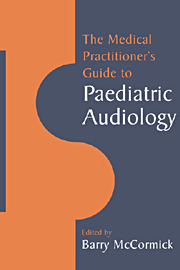Book contents
- Frontmatter
- Contents
- List of contributors
- Preface
- Acknowledgement
- 1 Introduction to hearing problems in childhood
- 2 Causes of deafness
- 3 Behavioural tests
- 4 Pure tone audiometry
- 5 Objective hearing tests
- 6 Middle-ear measurements
- 7 The management of otitis media with effusion
- 8 Management of unilateral hearing loss
- 9 Management of sensorineural hearing loss
- 10 Cochlear implants
- Index
9 - Management of sensorineural hearing loss
Published online by Cambridge University Press: 01 October 2009
- Frontmatter
- Contents
- List of contributors
- Preface
- Acknowledgement
- 1 Introduction to hearing problems in childhood
- 2 Causes of deafness
- 3 Behavioural tests
- 4 Pure tone audiometry
- 5 Objective hearing tests
- 6 Middle-ear measurements
- 7 The management of otitis media with effusion
- 8 Management of unilateral hearing loss
- 9 Management of sensorineural hearing loss
- 10 Cochlear implants
- Index
Summary
Introduction
With the exception of cochlear implantation, sensorineural hearing loss cannot be corrected by surgical or medical treatment. Early and appropriate selection and use of amplification is important, therefore, for the hearing-impaired child. Hearing aids bring sound more effectively to the ear, they do not restore hearing to normal.
It is necessary to select a hearing aid that will provide maximum benefit for the individual on a consistent basis to help promote the development of language and communication skills. For congenitally deaf children better speech intelligibility is achieved if amplification is available within the first 6 months of life (Markides, 1986). Appropriate amplification makes an important contribution to the linguistic, social, intellectual and emotional development of a hearing-impaired child.
As a general guideline, amplification is required for hearing losses greater than 30 dB averaged across the speech frequency range 500–4000 Hz in the better ear. When amplification is indicated in very young hearing-impaired children, only limited information about a child's hearing sensitivity in this range is available, either from behavioural responses, using distraction testing or visual reinforcement audiometry, or from evoked response audiometry. The limitations of auditory brainstem response testing has already been described in Chapter 5.
It is essential that any child fitted with hearing aids is closely monitored and many clinic visits are required, particularly in the first year following hearing aid provision.
- Type
- Chapter
- Information
- The Medical Practitioner's Guide to Paediatric Audiology , pp. 96 - 111Publisher: Cambridge University PressPrint publication year: 1995



